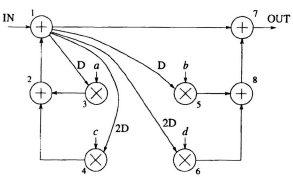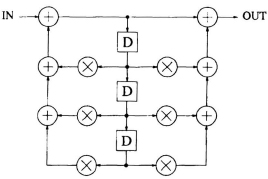2.7 PROBLEMS
- For the DFG shown in Fig. 2.12, the computation times of the nodes are shown in parentheses. Compute the iteration bound of this DFG using
(a) the LPM algorithm, and
(b) the MCM algorithm.
- Repeat Problem 1 for the DFG shown in Fig. 2.13 assuming that addition and multiplication require 1 u.t. and 2 u.t., respectively.

Fig. 2.14 The biquad filter.

Fig. 2.15 Direct-form 3rd-order IIR filter.
- Repeat Problem 1 for the DFG shown in Fig. 2.14 assuming that addition and multiplication require 1 u.t. and 2 u.t., respectively.
- Repeat Problem 1 for the DFG shown in Fig. 2.15 assuming that addition and multiplication require 1 and 2 u.t., respectively.
- Repeat Problem 1 for the DFG shown in Fig. 2.16 assuming that addition and multiplication require 1 and 2 u.t., respectively.
- Repeat Problem 1 for the DFG shown in Fig. 2.17 assuming that addition and multiplication require 1 and 2 u.t., respectively.
- Repeat Problem 1 for the DFG shown in Fig. 2.18 assuming that addition and multiplication require 1 and 2 u.t., respectively.
- Repeat Problem 1 for the DFG in Fig. 2.11 assuming that the execution time of each node is 1 u.t.
- Determine the iteration bound of the MRDFG in Fig. 2.19. Assume the execution time of each node to be 1 u.t. The following steps should be used: ...
Get VLSI Digital Signal Processing Systems: Design and Implementation now with the O’Reilly learning platform.
O’Reilly members experience books, live events, courses curated by job role, and more from O’Reilly and nearly 200 top publishers.

